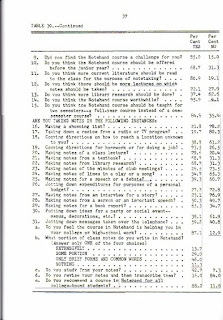Interlibrary loan came through for me once again. I was able to check out this master’s thesis from the University of North Dakota for a Gregg Notehand study which was conducted by Sister M. Anthony Naes:
Previous post: [ Hi Everyone ]
Next post: [ Comparing Outlines in Three Versions of Gregg ]
Leave a Reply
You must be logged in to post a comment.


Interesting. I've never heard of notehand before. How does it differ from other Gregg shorthand?
Notehand uses the same alphabet as the other Gregg editions but, for the most part, the words are more completely spelled out. There are fewer brief forms (only 42) and fewer abbreviated forms and blends to learn (making it faster/easier to learn). Notehand is still faster than longhand to execute, though probably not as fast as the other Gregg editions– it was never meant for verbatim dictation in the first place (the teacher's manual strongly states NOT to teach it this way). It's hard to say how fast a person could go using notehand since no one has ever really tested it out for its speed potential (wouldn't that be fun to try?!) It is a very non-intimidating, low-pressure shorthand to learn, which is why I decided to use it with my own kids. No penmanship rules are taught at all… in fact, the teacher edition mentions that it's ok if, say, a circle ends up on either side of a line. You pick up the rules just by reading and copying, for the most part. Gregg Notehand also has several chapters just on how to take notes (to learn how to distill the info you hear or read and put it into your own words)– that's something none of the other editions have. I find it a valuable study skill.
I thought it was interesting that the majority of the students in the study only used brief forms and common words in notehand in their notes– I see that as a potential area to try to improve upon. The class was only offered as a one-semester class however, so those students were probably just barely starting to get their sea legs, to be able to form new outlines from their own heads without reaching for a shorthand dictionary. If they'd had a second semester, the outcome would have probably been better. But overall, it was a very promising study for notehand, at least at this particular school mentioned in the study.
In an article called "The Impact of Notehand" it was argued how ridiculous it was to have both a personal and a separate vocational shorthand, and that it was ridiculous not to use personal shorthand for dictation. You can read the first page of that article here:
http://www.tandfonline.com/doi/abs/10.1080/08832323.1961.10117836
Notehand was published in the 1960s. It has fewer rules, fewer exceptions to the rules, and fewer brief forms to memorize than other forms of Gregg, so it can be learned more quickly.
It was meant to be a "personal shorthand" to be used by students taking notes in class, people writing in their diaries and so forth. It is commonly assumed that Notehand's maximum possible speed would be a lot lower than the mainstream forms of Gregg but this has never been proved.
Interesting. I like the idea of teaching students to put notes in their own words. That's a skill I struggled with in school.
Isn't it fascinating to think that there was a time when people were writing master's theses about shorthand?
Very much so! What might a master thesis about shorthand look like today?
Something like this book, probably:
http://www.amazon.com/dp/0472050559/ref=wl_it_dp_o_pC_nS_ttl?_encoding=UTF8&colid=3HBRIWJ3GQPFT&coliid=I3PUCO8KWQEJ2I